|
|
|
|
|
|
|
|
Mentally Practicing Best Responses To Emergency Scenarios Is Extremely Important... So That When a Disaster Is No Longer A Future Possibility, But is a Current Reality... You Will Do the Right Thing!
|
|
Effective Emergency Preparedness
Begins With Vizualizing and
Practicing Our Response - To
Potential Emergencies
|
We learn, from the book The Unthinkable - Who Survives When Disaster Strikes and Why by Amanda Ripley, that “lives will be saved when people have thought out before hand what they will do (individually and together with their emergency response group) when a disaster situation occurs, and especially when they have prepared and practiced (at least mentally)”. So,
- Study the information below and prepare for these emergency scenarios. The tabs are shown in order of probability for Utah Valley.
- Practice and teach the best responses to your family and others, because that is the best way for you to remember yourself.
- Keep yourself close to the spirit daily so you can have its guidance in your choices.
Think Ahead of Time What You Should Do In Case Of:
|
|
|
|
- Fire
|
There is a Virtually 100% Lifetime Chance That Your Household Will Face A Fire Emergency!
 Statistically, Statistically,
- Each household will face fire emergencies five times during an average lifespan.
- One in four households will have a reportable fire incident (one that involves the fire department).
- One in 10 households will have a household member injured in a fire.
- One in 89 households will have a household member injured in a “reported” fire.
- One in 1,442 households will have ahousehold member die as a result of a fire.
So, learn what to do from the experts (Here’s the basic three things on which to focus):
 Eliminate fire hazards. Eliminate fire hazards.- Have “working” smoke and fire alarms and fire extinguishers in each home or office place.
- Have a fire escape plan for each room.
- Crawl when there is smoke.
- Use window exits safely (have ladders available, for second story windows).
- Plan on leaving empty handed (because stopping to gather things may kill you)
Eliminate Fire Hazards
Think about and reduce risks from most common sources of fire:
- Cooking in the kitchen is the most common cause of home fires.
- Try not to leave the kitchen while something is on the stove and don’t leave anything flammable (oven mitts, dish towels, paper towels) near heating elements.
- Be very careful of cooking oils. They can catch fire easily, too.
- Heating Equipment is the second most common cause of home fires.
- Have your furnace inspected at least annually
- Keep portable heaters at least three feet away from anything flammable.
- Careless Smoking is the third most common cause of home fires.
- Use large, deep ashtrays; never place an ashtray on or near anything that will burn.
- heck furniture for fallen cigarettes/embers (a butt can smoulder for hours before causing furniture to burst into flames).
- Electrical Equipment and Wiring
- Make sure of adequate wiring capacity - so that circuirts or wiring isn’t overloaded
- Your electrical appliances don’t have loose or frayed cords/plugs
- Your outlets aren’t overloaded with plugs
- You’re not running electrical wires under rugs or heavy furniture
- You’re not overusing an extension cord. Be careful about do-it-yourself electrical projects; many home fires are caused by improper installation, so use a licensed electrician
- Candles
- Keep candles in a sturdy holder on a level surface
- Away from combustible materials and out of the reach of children or pets.
- Blow them out before leaving the room.
- Flammable Liquid
- Fuels, solvents, cleaning agents, thinners, adhesives, paints, and other raw materials – can ignite or explode if stored improperly.
- The vapours can easily ignite from even just high temperatures or weak ignition sources (one spark of static electricity).
- Don’t store flammable liquids near a heating source but, ideally, outside the home in a cool ventilated area, in approved containers.
- If your residence is in an area where wildfires could occur, prevent the ability of a wildfire to damage your home by:
- Creating a clear perimeter around your home that is free of brush, trees (at least, 30 feet, 100 feet is better)
- Use fire-resistant roofing and door materials
- Have roof sprinklers that can be turned on, without electricity
Have “working” smoke and fire alarms and fire extinguishers in each home or office places
Smoke alarms that are properly installed and maintained play a vital role in reducing fire deaths and injuries.
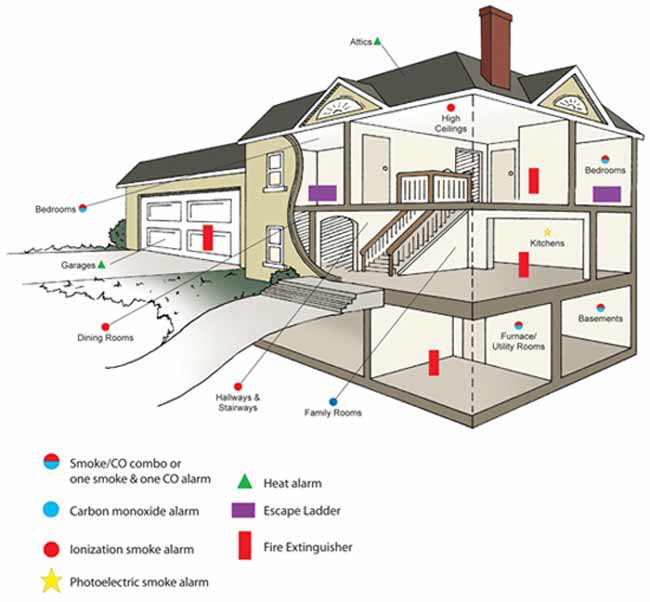 
Smoke alarms and fire extinguishers save lives. Almost two-thirds of home fire deaths resulted from fires in homes with no smoke alarms or no working smoke alarms. Having a working smoke alarm cuts the chances of dying in a reported fire in half.
If there is a fire in your home, smoke spreads fast and you need smoke alarms to give you time to get out. Here's what you need to know!
- Install smoke alarms in every bedroom, outside each sleeping area and on every level of your home.
- Test your smoke alarms every month.
- When a smoke alarm sounds, get outside and stay outside.
- Replace all smoke alarms in your home every 10 years.
Fire extinguishes give you the chance to stop a small fire (that is one that is confined to a small area, such as a wastebasket, stove or oven, and is not growing and the room is not filled with smoke. Here’s what to remember:
 To operate a fire extinguisher, remember the word PASS To operate a fire extinguisher, remember the word PASS
- Pull the pin. Hold the extinguisher with the nozzle pointing away from you, and release the locking mechanism.
- Aim low. Point the extinguisher at the base of the fire.
- Squeeze the lever slowly and evenly.
- Sweep the nozzle from side-to-side.
- For the home, select a multi-purpose extinguisher (can be used on all types of home fires) that is large enough to put out a small fire, but not so heavy as to be difficult to handle.
- Choose a fire extinguisher that carries the label of an independent testing laboratory.
- Read the instructions that come with the fire extinguisher and become familiar with its parts and operation before a fire breaks out. Local fire departments or fire equipment distributors often offer hands-on fire extinguisher trainings.
- Install fire extinguishers close to an exit and keep your back to a clear exit when you use the device so you can make an easy escape if the fire cannot be controlled. If the room fills with smoke, leave immediately.
- The primary elements of fire safety are fire prevention, early warning and safe escape. Every household should have a home fire escape plan and working smoke alarms.
Have a Fire Escape Plan for Each Room
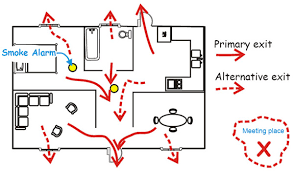 The most important part about staying safe in an emergency is to think about what could go wrong in advance as a household. The most important part about staying safe in an emergency is to think about what could go wrong in advance as a household.
- Visualize what could go wrong. Think about the differences for a fire starting in a furnace room, garage or basement. Assume it may happen while you are asleep.
- Think of how to get the most warning time in each situation, i.e. what type of fire or smoke alarm will give you the most warning and where to position it.
- Think of the best way to respond to each scenario. Teach each household member to check for a a “hot door”, how to crawl, how to cover the mouth and nose with “dry” (not wet) cloth so that smoke is filtered before going into the lungs.
- What if those who are upstairs are cut off from escaping down the stairs and out the front door. Do household residents, especially children, know how to get out of an upper story window?
|
|
- Flooding
|
|
|
A Freak Storm Can Create A Flooding Disaster or Great Danger!
Do You Know What To Do If Severe Flooding Occurs?
If there are flood warnings in the form of news broadcasts or dam failure siren, heed those warnings immediately.
The main action to be taken in the face of flooding —
- Head for higher ground. In our area, a dam failure could mean 4 to 20 feet of water depth at Carterville Road (depending on whether both the Deer Creek and Jordanelle dams have failed or just the Deer Creek). (See a map of water depth projections)
- About half of all flooding fatalities occur with persons inside vehicles.
- So, if you are driving and encounter a flooded road, stop, turn around, go the other way and head for higher ground.
- Keep in mind that water that was only six inches high at one moment, can rise two or three feet just seconds later. Only 18 to 24 inches of water can sweep cars away.
- Escaping from a car that is being swept away is nearly impossible.
- If your car stalls and the water is not too deep yet, abandon it, and move to higher ground on foot. Be especially cautious at night, when it is harder to recognize a flood danger.
- If you are caught inside a home with rising water, move up to the second floor, and if necessary to the roof. If possible, take warm clothing, a flashlight and a portable radio with you.
- If you are on foot and encounter water, stop, turn around, go the other way, and head for higher ground - Keep in mind that six inches of flowing water can knock you off your feet.
Go to this website for additional information on surviving floods: http://www.redcross.org/prepare/disaster/flood
Prevent Basement Flooding
Sudden, severe storms can create basement flooding disasters very quickly. This creates dangerous mold opportunities, and expenditures to replace carpeting and walls. So, think about this and prepare to not be subject to rainstorm water runoff problems. everal feet of water in a basement may probably not constitute a mortal dan ger, but the flooding can be prevented in most cases but thinking ahead and ensuring that:
- Roof construction and rain gutters and drains divert water far away from basement entrances (window wells and basement stairs).
- Drains near baseement entrances are unclogged and large enough to handle a high flow of water.
|
|
- Earthquake
|
|
|
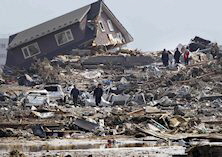 Over the next 50 Years, an Earthquake Is Not An If It Happens, But When It Happens! Do You Know What To Do When An Earthquake Occurs? Over the next 50 Years, an Earthquake Is Not An If It Happens, But When It Happens! Do You Know What To Do When An Earthquake Occurs?
When a major earthquake occurs... up to two hundred thousand homes in Utah will be shaken right off their foundations or will become debris piles. Gas, water and electrical services will most likely no longer function, and may, in fact, contribute to more hazards such as localized flooding, fires and electrical shock hazards.
One's immediate action in an earthquake should be to protect one’s head from falling debris, by getting underneath a sturdy table or next to a windowless interior wall.
- If inside a building, while shaking is occurring:
- Stay inside while shaking is occurring (many people are severely injured while leaving buildings due to falling debris)
- Protect your head
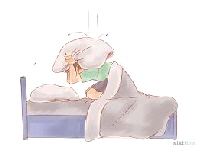 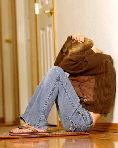  if possible, get your head underneath a sturdy table or chair or get next to sturdy furniture (with your head lower in height than that furniture so that it can take some of the blow of any falling debris), or get next to an interior wall. if possible, get your head underneath a sturdy table or chair or get next to sturdy furniture (with your head lower in height than that furniture so that it can take some of the blow of any falling debris), or get next to an interior wall.
- If possible, stay 15 feet away from windows and cupboards and shelves that may fall.
- If you are in bed, stay there, under the covers with a pillow over your head, or roll off the bed onto the floor with the blankets and pillow over you and lie beside (or under) the bed
- If outside go to a clearing and wait.
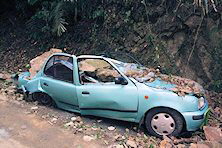   If driving, drive your vehicle away from anything that could fall (such as a bridge, tunnel, buildings or mountainside). If driving, drive your vehicle away from anything that could fall (such as a bridge, tunnel, buildings or mountainside).- If you are inside, after you are sure the shaking has stopped:
- You should go outside into a clear area.
- If you happen to be trapped underneath rubble:
- Move as little as possible
- Try to filter the air you breathe by breathing through a piece of clothing held over your mouth.
- Don't light a match.
- Don't shout,
- But do bang on pipes or anything else that makes a noise to let people know where you are.
Remember, contrary to popular Triangle of Life earthquake response theory which teaches to seek to immediately take refuge in a “triangle void” in order to avoid being crushed, the greatest danger, thousands of times greater than death by crushing, is serious head injury from falling debris. Protect your head first and foremost, look for a triangle void, second!
A couple of excellent websites include:
Earthquake Proof Your Home... go to Resources - Earthquakes and learn how to make your home as safe as possible from earthquake damage and mortal dangers..
|
|
- Bioterrorism or Bio-Epidemic
|
|
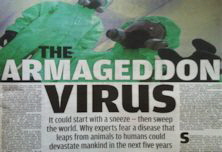 Most US Planners Consider A Bioterrorism/Epidemic As A Forgone Conclusion That It Will Happen! Do You Know What To Do To Protect Your Family? Most US Planners Consider A Bioterrorism/Epidemic As A Forgone Conclusion That It Will Happen! Do You Know What To Do To Protect Your Family?
Bioterrorism means the purposeful spreading of a lethal viruses or bacteria through air, water or food, which afterwards continues to be spread via CONTACT WITH INFECTED PERSONS, eventually becoming an epidemic of sick and dying people.
A Bio-epidemic, on the other hand, means that the epidemic began accidentally. The results, however, can be exactly the same as bio-terrorism — there will be numerous sick and dying people and rampant fear.
The public will probably NOT understand or recognize in real time how or when a bio-terrorism attack was initiated by an enemy or a bio-epidemic began. After an incubation period of time after an attack or event, there will be large numbers of people who are sick and dying, and panic will ensue.
 There are only two main methods that work in regard to bioterrorism/bio-epidemics. They are: There are only two main methods that work in regard to bioterrorism/bio-epidemics. They are:
- Isolation - meaning to keep people who are KNOWN TO BE INFECTED away from other people.
- Quarantine - meaning to keep people who MAY HAVE BEEN EXPOSED away from other people.
However, the only logical plan we can recommend is to apply the above methods in reverse, that is you must keep yourself and your loved ones away from people who may have been exposed or were exposed.
In practical terms this means:
- Remaining in one's home
- Not going to public gatherings
- Having absolutely no contact with the breath or body fluids of:
 Possibly exposed Possibly exposed- Sick
- Dead persons
- Staying away from the breath of a possibly exposed or sick person means:
- not being within 200 feet
- and especially not within an enclosed space such as a
- For those who choose to not do the above, then wearing HEPA filters that have been fitted to one's face so as not to breathe in contagion, and constantly washing hands with soap may provide some degree of protection, but HAZMAT suits are the only reliable way of protecting oneself.
Having your household stay isolated from the public should be continued for up to 45 days after the last known person becomes sick, and if you're not getting that kind of information, then plan on remaining isolated for 90 days from the start of the epidemic (as far you can observe). That means, you should have at least three months worth of food, water and other essentials in your home.
There is almost nothing “curative” that can be done in regard to those who are already infected, meaning that there is no antibiotic or antiviral or immune booster that will save infected people. Health care procedures are limited to supporting the infected person with fluids (IVs are helpful to keep a person hydrated in cases of diarrhea) and supportive nutrition, while the person's immune system deals with the disease.
Important Notes:
Many alternative health minded people strongly believe that vitamins, nanosized silver (Internet search: rxsilver), herbs, dichlor, etc. may provide significant help, but PLEASE DON'T COUNT ON ANYTHING SAVING A PERSON WHO HAS BEEN EXPOSED TO A BIOLOGICAL AGENT! The only thing that for sure works is staying isolated from others, SO THAT ONE DOESN’T BECOME INFECTED!
- To emphasize: preventing new infections is likely to be the only meaningful, life-saving action that can be taken in regard to bio-terrorism epidemics. THAT IS WHAT SHOULD BE FOCUSED ON.
- This primarily means excluding people from coming into your residence if they may have been exposed to contagion and it means none of your household can go out of your residence and have contact with others and then come back in.
- Once infected, whether an infected person lives or dies depends almost entirely on the condition of their immune system and the number of contagion that have entered their body.
- Having a strong immune system is not necessarily a good thing in regard to a bio-epidemics because persons with exceptionally strong immune systems may actually succumb faster to contagion, since their immune systems may mount such a powerful counter attack against the micro-organisms that too much collateral damage will be done to the body by the person's own immune system for that person to survive.
- The most likely to die are the very young and the very old. Middle age are the most likely to survive because their immune systems aren’t as strong as teenagers and young adults and yet are stronger than infants or the aged. Infants’ immune systems haven’t yet become strong and the immune systems of older people have become weak.
Continue learning at Resources - Bioterrorism.
|
|
- Nuclear Holocaust
|
|
|
What About Nuclear Holocausts That According to Prophets, “Surely Shall Come”?
Do You Know What To Do To Protect Your Family?
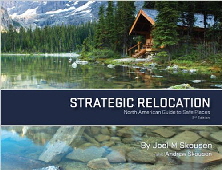 Consider not living near, nor working near military targets or nuclear power plants (especially, as the signs of the times indicate that wars are more likely to occur). See more about this at bottom. Consider not living near, nor working near military targets or nuclear power plants (especially, as the signs of the times indicate that wars are more likely to occur). See more about this at bottom.
If a nuclear attack has occurred, then you should immediately seek shelter indoors (and preferably in a basement). This is the main action to take after a nuclear event.
We recommend reading this website on surviving a nuclear attack in order to understand the actions you should take to live through a nuclear attack, nuclear reactor meltdown which summarized are:
- If you can see the nuclear flash/fireball then quickly (you may not have very long) get behind
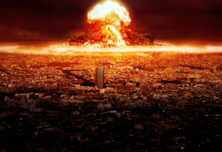 something VERY SOLID or get down into a depression in the ground. The initial heat and shock wave are deadly. You do not want to be in its path. something VERY SOLID or get down into a depression in the ground. The initial heat and shock wave are deadly. You do not want to be in its path.
- After the shock wave has passed, go inside a a building with a basement. If there is no basement, go inside a building and get into the center most part of it (with the most amount of walls possible between you and the outside and with no windows).
- Stay inside for at least 2 days after the attack, 21 days is better and the only way to know for sure when it is safe to be outside is to have a radiation meter (Geiger counter).
- The best barrier between you and radiation is 2 to 3 feet of soil.
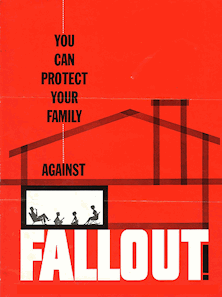 There are no public fallout shelters in Utah County, so you're on your own. There are no public fallout shelters in Utah County, so you're on your own.- Tape off your home (or probably a single room in your home in which you will stay) so that outside air(carrying radioactive particles) doesn't enter, using plastic sheeting and duct tape. Then have filtered air coming into that room. If you can't do the latter, don't do the former.
- Once you come outside, your safest bet is to eat stored foods and water, as everything outside will be contaminated with radioactive particles.
- Up to 21 days of staying inside means that you had better have your basic supplies of food, water and other supplies. Things you will want to have:
- Stored Food and Water
- Portable or sawdust toilets (it will be very smelly, otherwise after one to three weeks)
- An air filter so that you can bring outside air into your fallout shelter without also bringing in radioactive particles
- Radios (so you can hear news)
- Radiation mete
Strategic Thinking Needed Now:
(the warnings below don't apply to Orem Utah residents (who do not travel outside of Orem), but do apply to persons working in Ogden or Lehi their children and grand children who may work or live near nuclear reactors or military targets)
Nuclear Reactors:
A Nuclear attack by an enemy or rogue nation or empowered terrorists is not the only danger or worry because 99 nuclear reactors exist in the United States in 30 states (fortunately, none of these are in Utah).
Although officially denied strenuously, you can be absolutely sure that some of these reactors will not survive a long-term loss of electrical power, but in some cases, the cores will become critical (fission will occur and radiation will be released) when safeguards to prevent critical mass or release of radioactive particles into the atmosphere fail - once back up power is gone). As we go into the last days of the earth’s existence, the only advice that makes any sense is to NOT LIVE WITHIN 100 MILES of a nuclear reactor, unless you have a mountain between you and the nuclear reactor and the winds constantly blow away in the other direction. If you disregard this advice, WHEN there is a long-term loss of electrical power, you will possibly get to know what is called radiation sickness.
Military Targets:
Living near (within 7 miles of) probable military targets all but guarantees that one doesn't have to worry about surviving a nuclear event (because one won't survive).
So, if you are a survival minded person, the only sensible thing to do is not live near to such military targets. In Utah, this means not living within 7 miles of Hill Air Force Base, or within 7 miles of the the NSA data collection (spy) facility north of Lehi. Although, nuclear strikes against military targets won't release radioactive fallout to the extent that could occur with nuclear reactor events, one may still prefer to have even more than 7 miles distance from one's residence or work place and a military target.
|
|
- EMP Event
|
|
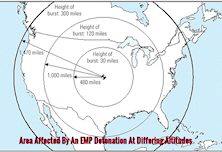 Can You Live As People Used To Live 150 Years Ago — Without Can You Live As People Used To Live 150 Years Ago — Without
- Electricity
- Refrigeration
- Toilets
- Garbage Collection
- Running Water?
- Stores
When an EMP Occurs - You Will Find Out!
An EMP Event would occur most likely as a detonation of an Electromagnetic Pulse Thermonuclear Device (or several of them) high in the atmosphere (an attack by an enemy). An EMP event is, also, theoretically possible to result from a massive solar flare. In either case, the public would probably have no recognition of the actual event, but would only notice the results.
An EMP event would cause irreparable damage to electronics and electrical circuitry in low-orbiting satellites, flying aircraft and virtually all electronics and electrical systems on the ground, including electronics and electrical systems in cars, buses, etc. So, TV and radio would stop working. Phones, electrical appliances and virtually all systems that utilize electricity would no longer function. Airplanes would fall from the sky and most cars would stop working.
If a central to North America, high altitude EMP Event, were to occur, it is believed that, a single EMP event could cause:
- Potentially, all electrical power in the U.S. (the power grid) to fail;
- Along with virtually all electronics and products and services that depend on electricity or electronics.
- Since, the country is so dependent on electrical power, electronics, telecommunications, information networks and transportation systems that rely on electrical systems and electronics, an EMP event would be totally devastating, with losses of life predicted to possibly reach as high as 70% to 90% of the total population in just one year.
Two fictional books have been written to describe the effects of an EMP event.
- One of these is called One Second After. It is quite horrific and compelling in terms of our need to get ready.
- The second book (much less frightening, but still giving a good wake up call) is When the Lights Went Out by Jack Monnett and is written for LDS audiences.
To imagine how to respond to an EMP Event, one needs to imagine a modern world that is reduced suddenly to having no electricity, no telephones, no stores, no banking, no pumped delivery of fuel or water, no sanitation services, no transportation. The greatest loss of life 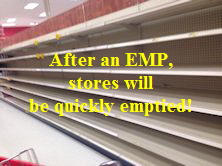 would probably come through diseases resulting from lack of sanitation (like plagues of the past), followed by starvation. would probably come through diseases resulting from lack of sanitation (like plagues of the past), followed by starvation.
Large cities would be the worst possible place to be, since people there are totally dependent on sewage and garbage removal (that would no longer occur) as well as water and food being transported into the cities from farmlands and rivers. The sheer amounts of people competing for dwindling supplies of food, water and medications is the greatest danger in large cities.
There are only two best plans for those who live in cities:
- Join with a prepared group of people that work together to keep each other safe and that shares food, water and medications and properly disposes of wastes and that immediately begins to grow food and forage for water. The larger the city, the less likely this is a viable plan, especially in regard to water.
- Quickly leave the city and go to predesignated, isolated “safe place”. Ideally, a safe place would be a small rural town where plan 1 can be implemented. This one is hard to implement since an EMP will render post-1960 vehicles useless.
An EMP event is arguably the worst of all scenarios. Recovery could span decades. Homes would be turned into caves with no heating, air-conditioning, refrigeration, running water or sanitation. Medicines would quickly be used up. Lawlessness would result as people would turn against each other in competition for remaining supplies of food, water and other resources.
More On How To Survive an EMP:
The effect of an EMP won’t be for months. It will be years before normal power is restored. Water, as in drinking water and the lack thereof, will kill many more Americans than will radiation from nuclear plants. Starvation will be the next highest killer. Radiation will be a problem in some areas, but won’t be the killer many fear… because.plain old shortages of clean water and food will kill more than the radiation problem. Government experts expect a 70% to a 90% die-off from starvation after an EMP…not from nuke plant radiation. There is a lot you can do on your own to protect yourself…food and water filtration should be your first bulwark against this scenario. Shelter comes after food and water, unless you live in the shadow of a nuke plant.
Each person’s location will determine priorities, but food, water, and meds are the first and easiest things ordinary people can work on as a hedge against this sort of disaster. Start with bulk stocks of beans, rice, coconut or olive oil, salt, sugar, etc. Cheap and dense for storage, they can keep you alive and healthy for years for little money. Look into serious water filtration capacity, such as the Lakewater Filter. Solar, wind, and hydro power will function just fine provided you have kept spare electrical resources in a Faraday cage.
In the days, weeks, months and years after an EMP Event, safe water, medicines, storage foods, food production, animals and hunting weapons would be valued above everything else. Surviving an EMP event depends on the community one lives in and one's ability to live like people did 150 years ago, and one’s ability to avoid improper sanitation-borne-diseases and defend against armed mobs. In most densely populated areas (i.e. cities), the prospects would be bleak. Your greatest survival opportunity will come by living in highly religious, cohesive communities or moving out to farm areas where there will be food and water. Here is a podcast discusing how to survive an EMP.
What one needs in order to survive boils down to:
- Water and food - having stored water and food and foraging and production capabilities to obtain water and food.
- Clothing and shelter - being able to survive in cold temperatures, i.e. having adequate shelter and clothing
- Medicines - either modern or herbal medicines that will enable surviving disease conditions and infections
- Sanitation - disposing of human wastes far from living quarters
- Defense - being able to avoid conflict with desperate people
|
|
|
|
|
|
|
|







